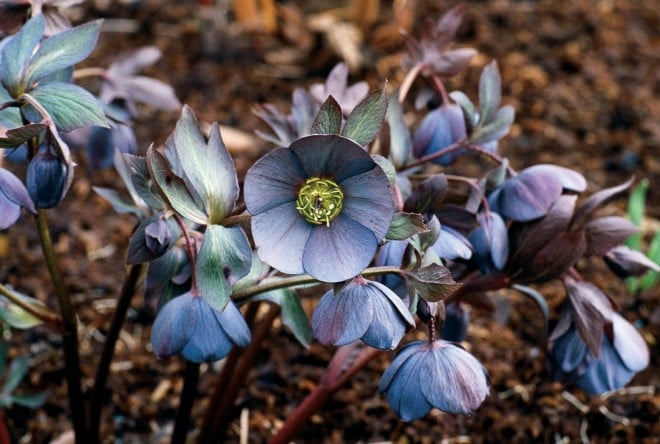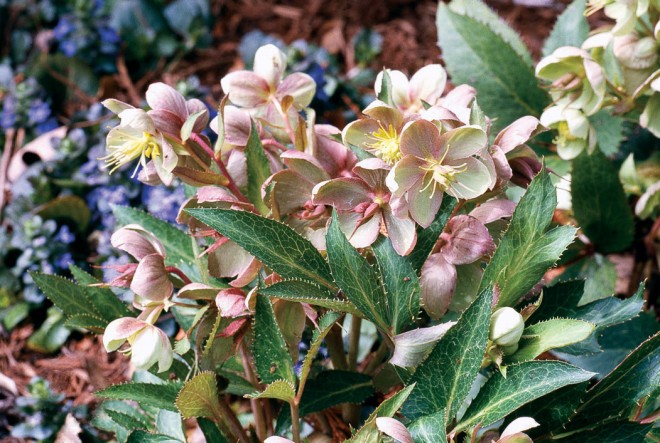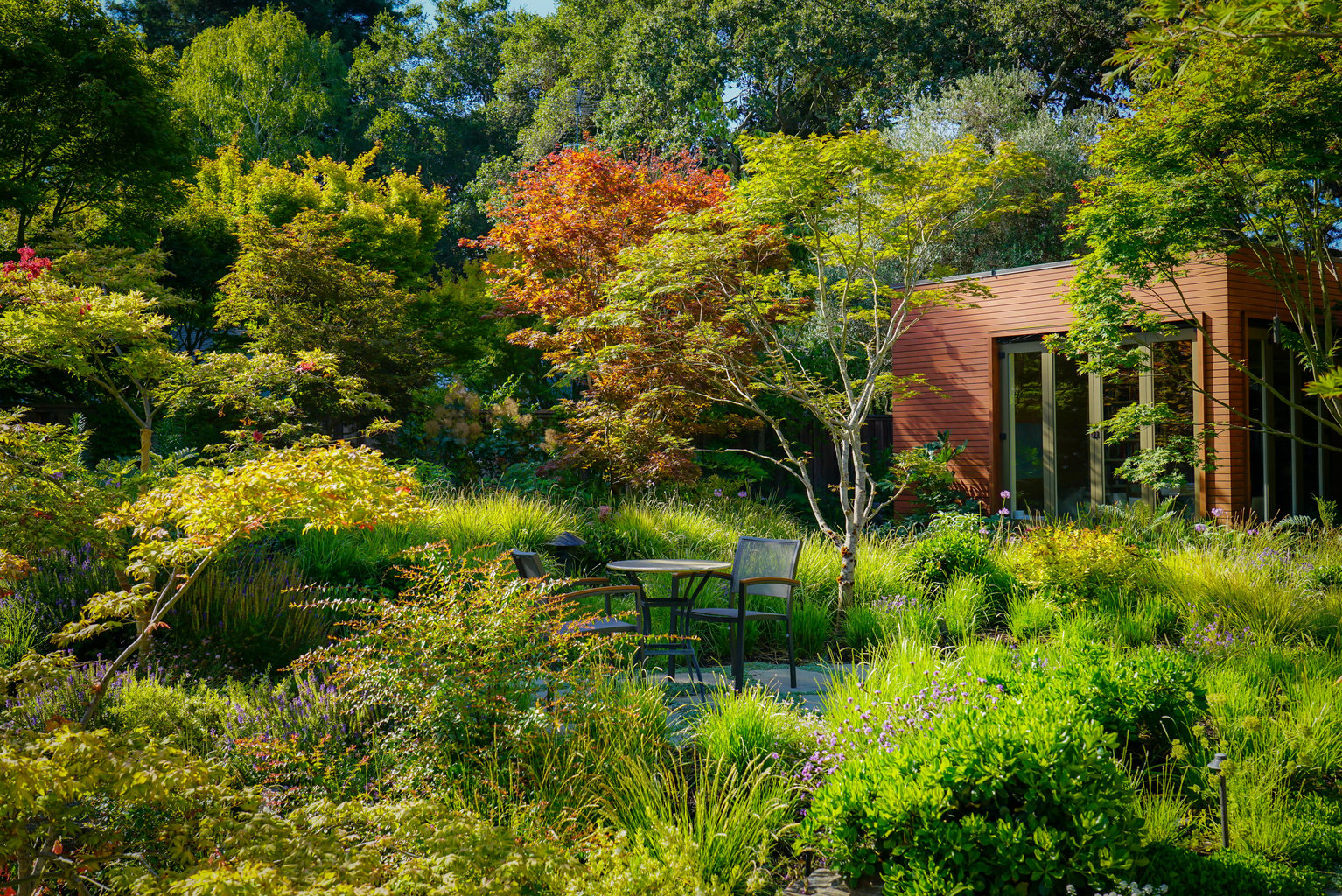
Not Your Mother’s Hellebores: A New Look at Species and Hybrids (Part 2)

Contributor
[sidebar]“The Lent Hellebores . . . have become,” said Miss Gertrude Jekyll, “much mixed by hybridization, both natural and intentional, and though they are no doubt kept distinct in botanical gardens, those to be found in private places are for the most part hybrids.” This is all to the good from the gardener’s point of view, for we find among these hybrids many lovely colors—soft ruddy, purplish tones, greenish tints, cream, blush, even pure white ones and some with spotted flowers, or they may be suffused with other hues.
Louise Beebe Wilder, The Garden in Color, 1937 [/sidebar]
If Gertrude Jekyll and Louise Beebe Wilder could see today’s hybrid hellebores, they would no doubt be stunned. Their lovely “soft ruddy, purplish tones” have been replaced with rich burgundy, plum, and deep black purple in garden hybrids. Selections from interspecific and intersectional crosses are widely available in a range of sizes, leaf shapes, and flower colors, thanks to the miracle of tissue culture. Delicate wild species are at last available from both wild collected and garden seed, further expanding the breadth of the genus for West Coast gardeners from Vancouver to San Diego.
Interspecific and Intersectional Hybrids
One of the most perplexing and exciting facets of hellebores is that so many of the species interbreed. The most familiar inters-pecific crosses are those that produce the current line of exceptional garden hybrid hellebores (Helleborus xhybridus). In addition to crosses within the genus’s botanical sections, many species are cross-fertile between sections, which can result in some dazzling effects as well as some superb garden plants. Most intersectional crosses involve just two parents, but H. xericsmithii involves three species. The majority of intersectional hybrids produce sterile offspring, but hybrid vigor makes them robust and floriferous. While the ultimate garden worthiness of new hybrids will surely be determined by time, the prospect of untried crosses is a veritable candy shop for the kid in every hybridizer. Most should prosper throughout the western region of North America; plants with H. niger as a parent may need winter chilling that would limit their performance in warmer parts of southern California.

Helleborus x hybridus
The Lenten rose (Helleborus orientalis) arguably lays claim to the showiest flowers in the genus. They nod gracefully or are out-facing, held free of the leaves on branched stalks. Large, graceful flowers in a variety of colors give H. orientalis and its hybrids preeminent status. Long referred to as “Orientalis hybrids,” modern garden hybrid hellebores (H. xhybridus) are actually complex hybrids involving H. orientalis and many other species. The rich purple and black flowers take their color from H. torquatus and H. purpurascens. The yellows owe a debt to H. odorus, while the greens are derived from H. cyclophyllus, H. odorus, and others. Some garden hybrids do not involve H. orientalis at all!
Many of the first garden hybrid hellebores taken into breeding lines by England’s influential hybridizers were unnamed plants of exceptional quality. As superior plants appeared, far too many were named, including some nearly identical to others. This muddied the water as far as the true identity of the named plants, so much so that, with the exception of recent advances in tissue culture of the devilishly difficult H. xhybridus, most named selections no longer exist.
Modern breeding lines provide us with a new standard. Each generation sees improvements over the previous, often making tissue-cultured cultivars obsolete before they reach market. One exciting advance is with double flowers. By introducing blood from selected hybrids into the double H. torquatus forms, a group of plants with larger flowers arose. Doubles from H. torquatus are generally slower to mature and less robust than those created from older double H. xhybridus selections. Newer doubles bred from H. xhybridus are vigorous and large flowered. Today’s hybrids are large and full flowered, with rounded, overlapping petals. Singles, semi-doubles, and full, elegant doubles in pure, strong colors, as well as picotees and elegantly spotted flowers, set a new standard. [Sunset zones 2b-10, 14-24]
Helleborus x nigercors
Corsican hellebore (Helleborus argutifolius) hybridizes with Christmas rose (H. niger) to produce H. xnigercors, a tough and floriferous plant with exceptional hardiness and unusual heat tolerance. The leaves of these hybrids often favor the Corsican parent in size and shape, but the flowers almost always resemble those of Christmas rose. The leaves, on eighteen-inch plants, are usually heavily toothed and sturdy, often blue green or veined with white when young; they turn green with age. Flowers are large, roughly two to four inches wide, and creamy white; some are tinted pink, a trait inherited from anthocyanin-rich H. niger selections such as the Sunset Group. Flowers with a brush of green down the center of the sepal are also common.
The carriage of flowers on H. ×nigercors is unusual, combining both caulescent (stemmed) and acaulescent (stemless) traits: some flowers are produced at the top of the leafy stems, as with H. argutifolius, whereas others are borne on stems arising directly from the roots, similar to H. niger. The demonstrated hardiness range is USDA zones 6-8. As with most hellebores, H. ×nigercors appreciates well-drained and fertile soil, tolerates sun or shade, and easily adapts to pot culture.
Helleborus xnigercors was initially available only in seed strains, the most common of which was the Blackthorn strain, whose flowers are pure white or white with green.
With the discovery that hellebores can be propagated by tissue culture, a number of cultivars of this hybrid have become widely available. Among them are: ‘Green Corsican’, whose green white flowers age to pure green; ‘Honeyhill Joy’, selected by Jim and Audrey Metcalf of Portland, Oregon, with gray green leaves and many creamy flowers; ‘Silver Moon’, with cool white flowers over silvery foliage; ‘Valentine Green’, introduced by Heronswood, offering large white flowers with a faint green blush down the center of each sepal, aging to lime green; ‘Vulcan Beauty’, from the Netherlands, with cream flowers over gray green foliage; and ‘White Beauty’ (also listed as ‘Micha White Beauty’), with cream flowers that fade to green.

Helleborus x sternii
Helleborus argutifolius and H. lividus hybridize to produce the fertile hybrid H. xsternii, named for Sir Frederick Stern, in whose garden it originated. Individual plants of this caulescent hybrid vary in size, shape, foliage color, and bloom size. Some are tall, up to two feet, with green foliage. Others are short, as little as six inches, and resemble H. lividus, with deep purplish rose on the back of the leaves. The leaves are exceedingly varied, often combining parental traits. For example, they may possess the toothed edges and intricate veining of H. argutifolius, and the silvery blue color and purplish reverse of H. lividus. Clumps produce multiple stems bearing up to a dozen flowers, each two inches or more across in terminal clusters. Plants are root hardy to USDA zone 6 [Sunset zones 4-9, 14-24], possibly colder if provided with good drainage, but are susceptible to black spot and frost damage when grown outdoors near the limits of their hardiness; plants with silvery foliage, reminiscent of H. lividus are more susceptible than green leaved individuals.
Several seed strains of Helleborus xsternii are available, including: the Blackthorn Group, with striking blue foliage complementing cream and dusty pink flowers; the hardy Montrose strain, with green gray foliage and chartreuse flowers blushed pink; and Pine Knot strain, with silver gray foliage and rose pink flowers
‘Boughton Beauty’ is likely the best known of the cultivars; it has gray leaves with red reverse, rose red stems, and cream flowers flushed pink. Other cultivars are: ‘Bulmer’s Blush’, with narrow, marbled leaves on red stems, and chartreuse flowers aging to dusty pink; ‘Clifton Grey’, a New Zealand selection with gray leaves marked by heavy veining; ‘Fire and Ice’ (sometimes listed as a cultivar of H. argutifolius), a variegated selection with red flushed stems; and ‘Rachel’, from Tasmania, with silvery, toothed leaves and red reverse, and chartreuse flowers flushed with rose.

Helleborus x ballardiae
Helleborus lividus combines with H. niger to produce H. xballardiae (previously known as H. xnigriliv), named for English hybridizer Helen Ballard. At a petite twelve to fifteen inches tall, this hybrid is much smaller in all its parts than H. xnigercors. Leaf shape is typically reminiscent of H. niger, although sometimes with more divisions; leaves often show the veining or marbling inherited from H. lividus and may display rose-colored undersides. The flower stems, often reddish rose in color, support several two- to four-inch flowers per stem. This hybrid is hardy to USDA zone 7, responds well to pot culture, and is tolerant of a wide range of light conditions, from full sun to full shade.
Helleborus x ericsmithii
Helleborus ×sternii, when crossed with H. niger, produces H. xericsmithii (previously known as H. xnigristern), named for Eric Smith, one of the first to make the cross. Traditionally a small plant only ten to fourteen inches tall, with foliage that is often quite blue, H. xericsmithii can resemble each of the plants involved in this three-way cross. In some seedlings, the leaves are toothed; in others, more rounded. Leaf veining is common, but the foliage is sometimes pure green. Flowers are borne in clusters atop short stems, each cluster having multiple buds. The flat-faced, cream to rosetinted flowers are two to four inches in diameter. The demonstrated hardiness range is from USDA zones 6 to 8. With a long flowering period and extremely attractive foliage, H. xericsmithii is certainly worth considering as a container plant; it responds well to being grown in a freely draining soil medium with adequate nutrition, in either sun or shade.
The Blackthorn form is a seed-grown strain with attractive blue green leaves and silvery veins; flowers are cream to dusty rose.
The Ashwood form was the first to be produced by tissue culture; it has blue green leaves with cream venation and a rose underside, and creamy flowers blushed rose pink on the reverse and on the stems. Others propagated by tissue culture include: the sometimes fertile Heronswood form, with attractive foliage characteristic of H. xericsmithii and large ivory flowers with red stems; ‘Pink Beauty’ (also known as ‘Micha Pink Beauty’), with dusty rose flowers; and ‘Sun Marble’, from Sunshine Farms, a representative selection with cream veins on blue green foliage.
New Hybrids to Watch For
We are enjoying an explosion in the number of intersectional and interspecific crosses, as hybridizers seem to delight in pollinating the most unlikely plant pairs with one another. The recent availability of formerly rare or unusual species has provided new material to work with. Most of the current work involves Helleborus niger, which crosses with the species listed above as well as with H. vesicarius and H. thibetanus, and quite possibly other species. When these hybrids become more commonly produced by tissue culture, nurseries will offer many more tempting selections.
Helleborus ‘Ivory Prince’ is a complex cross of H. niger with H. xericsmithii, bred by David Tristram using a seedling from ‘Potters Wheel’, his father’s famous selection of H. niger. Plants are similar in appearance to a good form of H. xericsmithii, with cream buds flushed pink, opening to outward-facing flowers that are streaked with green on the face and rose on the reverse. These sterile plants are wonderfully floriferous. [Sunset zones 2-9, 14-17]

Kevin Belcher, of Ashwood Nurseries in the UK, crossed Helleborus niger with H. thibetanus to produce ‘Pink Ice’, the first recorded cross of these two species. The result of eight years of work, this beautiful hybrid inherited its silvery pink color, darker pink veining and ruffled sepals from H. thibetanus; the broad, flat flower face comes from H. niger. The sterile flowers are produced in branched clusters with each flower approximately two inches across on plants that reach twelve to fifteen inches tall.

Belcher was also the first to cross Helleborus niger with H. vesicarius, producing a plant he named ‘Briar Rose’, which has the bright celery green foliage of H. vesicarius, but is evergreen like H. niger. The flowers are one to one-and-a-half inches across, creamy white with a wide rose rim around the outside of the flower. This exciting hybrid is virtually untested in the garden. Outdoor trials at Ashwood Nurseries have met with only limited success.

The Yokoyama Nursery in Japan introduced ‘Snow White’, a hybrid from a white-flowering H. ×hybridus crossed with H. niger. It has large, outward-facing flowers that open as flat as those of H. niger. The leaves are intermediate between the parents. This previously undocumented hybrid was spontaneous, with H. niger as the pollen parent.
A number of breeders in the US and Europe are experimenting with crosses involving Helleborus multifidus, notable for its intricately divided leaves, and good color selections of H. xhybridus, in the hope of producing plants with flowers of excellent form and color combined with lush, deeply dissected foliage. Northwest Gardens Nursery in Eugene, Oregon, has a fine strain derived from H. multifidus subsp. hercegovinus that offers a stunning mix of red and purple flowers.
Helleborus niger, H. vesicarius, and H. thibetanus are remarkable in that they cross freely outside of their botanical sections within the genus. Traditionally sterile, H. xericsmithii and H. xnigercors may occasionally be fertile, which would open other venues for breeding. Belcher and the team at Ashwood Nurseries, in company with other hellebore enthusiasts around the world, eagerly await the flowering of the newest interspecific crosses. Plants of H. niger x, H. foetidus, H. niger x, H. viridis, and H. niger x, H. xhybridus have just begun to flower in the Ashwood greenhouses. Stay tuned!
Adapted from Hellebores: A Comprehensive Guide, by C Colston Burrell and Judith Knott Tyler, published by Timber Press in 2006. Part 1 appeared in the January 2007 issue of Pacific Horticulture.
Share:
Social Media
Garden Futurist Podcast
Most Popular
Videos
Topics
Related Posts

Low Maintenance Gardens – Better for Pollinators and People
Autumn 2022 “I come out every day. It’s therapy, my meditation.” Janet’s young garden transformed from overgrown, invasive plants to mostly natives. The dailiness of

Invasive Plants Are Still Being Sold: Preventing Noxious Weeds in Your Landscape
Autumn 2022 With so many beautiful ornamental plant species and cultivars throughout California and the Pacific Northwest, how do you decide which ones to include

Garden Design in Steppe with Transforming Landscapes with Garden Futurist Emmanuel Didier
Summer 2022 Listen to full Garden Futurist: Episode XVII podcast here. Emmanuel Didier, Principal and Creative Director at Didier Design Studio is a leading figure

Seslerias: Versatile Groundcover Meadow Grasses
Summer 2022 Without question, the most beautiful and versatile of all the groundcover meadow grasses are the moor grasses (Sesleria). Moor grasses tick off all










Responses